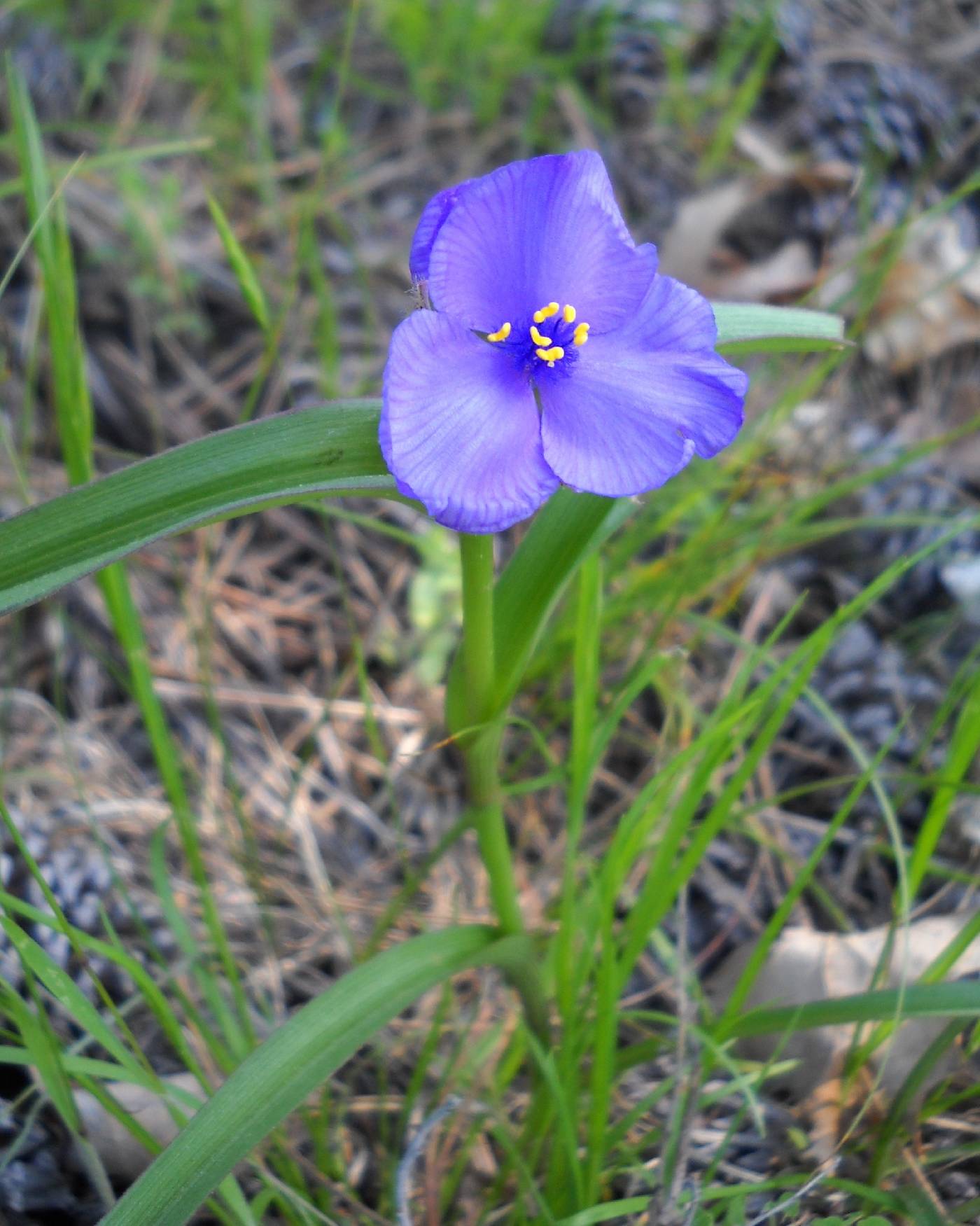|
|
|
|
Family: Commelinaceae
longbract spiderwort
|
Herbs, erect or ascending, rarely rooting at nodes. Roots not brownish-tomentose. Stems sparsely branched, 5--45 cm, glabrous, or puberulent distally. Leaves stiff; blade bright green, linear-lanceolate, 15--29 ´ 0.9--2 cm (distal leaf blades equal to or narrower than sheaths when sheaths opened, flattened), apex long acuminate, glabrous. Inflorescences terminal, solitary, sometimes also lateral and pedunculate from distal nodes; bracts foliaceous, glabrous, or rarely sheath puberulent. Flowers distinctly pedicillate; pedicels 1.8--3.3 cm, pubescent with mixture of glandular, eglandular hairs; sepals, 10--13 mm, densely pubescent with mixture of glandular, eglandular hairs, glandular hairs numerous, conspicuous, longer hairs 1.5--6 mm; petals distinct, usually bright rose, less commonly blue, ovate, not clawed, 18--19 mm; stamens free; filaments bearded. Capsules 5--6 mm. Seeds 2--3 mm; hilum as long as seed. 2n = 12, 24. Flowering spring (Apr--Jun). Prairies, spreading to thickets, roadsides, and railroad rights-of-way; Colo., Ill., Ind., Iowa, Kans., Mich., Minn., Mo., Mont., Nebr., N.Dak., Okla., S.Dak., Wis., Wyo. The record of this species from Indiana (E. Anderson and R. E. Woodson Jr. 1935) was based on a depauperate specimen of Tradescantia virginiana (E. Anderson 1954); the internodes on an unnumbered specimen collected by Mason, however, deposited at the Field Museum in Chicago, are puberulent with glandular and eglandular hairs. I have seen this character in an occasional specimen of T. bracteata but never in T. virginiana. Tradescantia bracteata was distinguished from T. occidentalis partly by the former's unbranched stems versus the freely branched in T. occidentalis (M. Bolick 1981). By using this feature, branching specimens from Minnesota would be identified as T. occidentalis, although their sepal pubescence and lax, green, pubescent-margined bracts and leaves clearly place them in T. bracteata.
Perennial herb to 40 cm tall Stem: fairly stout, erect to ascending, rarely branched, rarely rooting at nodes. Leaves: stiff, bright green, 12 - 35 cm long, 0.8 - 1.5 cm wide, linear to lance-shaped wih a pointed tip, the base wrapping around the stem to form a sheath. The blade width equals the circumference of the sheath. Inflorescence: terminal (rarely lateral), usually solitary, subtended by a hairless leaf-like bract that is longer and wider than the leaves. Flowers: borne on a 1.8 - 6 mm long stalk densely covered with curved non-glandular and glandular hairs. The three sepals are 1 - 1.5 cm long with a rounded to slightly pointed tip and are densely covered with curved non-glandular and glandular hairs, and the three rose to blue petals are 1.5 - 2 cm long and not clawed. Stamens not attached, filaments bearded, style thin. Fruit: a three-valved and three-chambered capsule 5 - 6 mm long, containing six 2 - 3 mm long seeds with a scar as long as the seed. Similar species: The Tradescantia species found in the Chicago Region can most easily be distinguished by the size of their leaves and presence or type of hairs on the sepals, flower stalks and bracts. Tradescantia subaspera leaf blades are wider than the sheaths (over 2 cm) and less than 10x as long as wide; the sepals and flower stalks are hairy. Tradescantia virginiana leaf blades are as wide as or narrower than the sheaths (less than 2 cm) and more than 10x as long as wide; the sepals, flower stalks and bracts are hairy. Tradescantia ohiensis leaf blades are as wide as or narrower than the sheath (less than 2 cm) and more than 10x as long as wide; the sepal tips are sometimes hairy and the flower stalks are hairless. Flowering: late May Habitat and ecology: Introduced from the western U.S. The two specimens collected in the Chicago Region were found along railroads. Occurence in the Chicago region: non-native Etymology: Tradesecantia is named after John Tradescant (d. 1638), the gardener of King Charles I. Bracteata means "with bracts." Author: The Morton Arboretum Stem rather stout, straight, rarely branched, (1-)2-4 dm at anthesis, glabrous or minutely puberulent; lvs glabrous or sparsely pilose at base, the larger 8-15 mm wide; bracts often longer and wider than the lvs; cyme usually solitary and terminal, an additional lateral one rarely present; pedicels and sep densely and softly villous with mingled glandular and eglandular hairs 1-1.5 mm; sep obtuse or subacute, 10-14 mm; pet rose or blue, 15-20 mm; 2n=12, 24. Prairies; s. Ind. to Minn., w. to s. Mont., e. Colo., and n. Okla. Gleason, Henry A. & Cronquist, Arthur J. 1991. Manual of vascular plants of northeastern United States and adjacent Canada. lxxv + 910 pp. ©The New York Botanical Garden. All rights reserved. Used by permission. |


